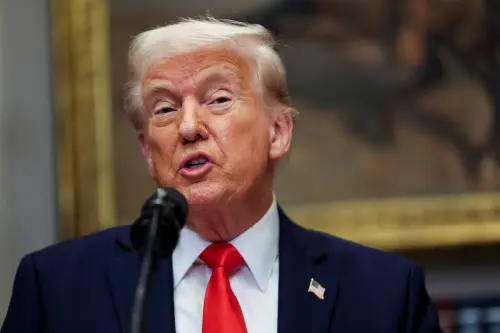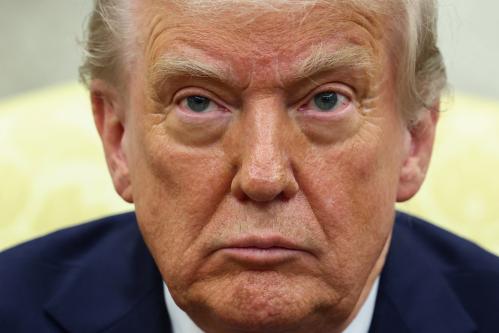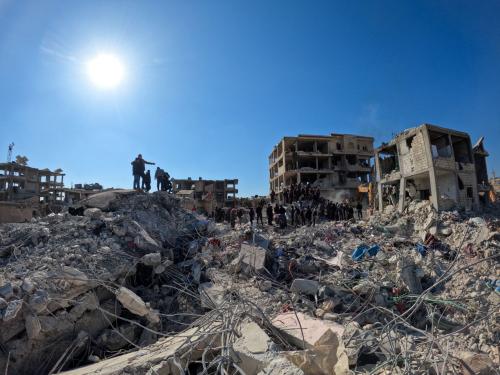Speaking on Prague’s Hradčany Square on April 5, 2009, President Barack Obama laid out his vision for managing nuclear arms. After major strides in 2009-2010, progress slowed, due to domestic political opposition and Moscow’s recalcitrance—and also to the administration’s timidity. With U.S.-Russia relations on a downward slide, securing a transformational legacy on nuclear weapons may be slipping out of the president’s reach.
U.S. and Russia make a New START
President Obama came to office seeking to do big things on nuclear arms. In an April 1, 2009 meeting, he agreed with then Russian President Medvedev to bilateral negotiations on strategic nuclear arms reductions. Four days later in Prague, he laid out an ambitious agenda, setting the goals of reducing the role and number of nuclear weapons in U.S. security policy and ultimately of a world without nuclear arms.
Negotiations on what became the New Strategic Arms Reduction Treaty (New START) made rapid progress. When Obama and Medvedev met that July in Moscow, they announced the parameters for the agreement.
April 2010 proved a watershed month for the president’s arms control and non-proliferation agenda. On April 8, he returned to Prague to sign New START, which required that the United States and Russia each reduce its strategic forces to no more than 1550 deployed strategic warheads on 700 deployed strategic missiles and bombers.
Just days before that, the administration issued its nuclear posture review. It put to paper the goals of reducing the role and number of nuclear arms and of creating the conditions in which the sole purpose of U.S. nuclear weapons would be to deter a nuclear attack on the United States and its allies.
On April 12-13, the president hosted the first Nuclear Security Summit. Some 40 leaders attended the meeting, which launched a process to secure weapons-usable highly-enriched uranium and plutonium stocks around the world.
One year after his Prague speech, Obama could point to a multi-pronged effort to transform American nuclear policy and reduce nuclear risks. He made clear his intent to do more. When signing New START, he called for negotiations on further reductions, including non-deployed strategic nuclear weapons and tactical nuclear arms—creating the possibility that, for the first time, the United States and Russia might negotiate limits on their entire nuclear arsenals.
Administration officials expected a quick ratification process for New START. They hoped to use momentum from that to pivot to ratification of the Comprehensive Test Ban Treaty (CTBT), sitting in limbo since a failed ratification vote in 1999.
Things began to get tougher that summer, as securing a two-thirds majority in favor of New START ratification turned out to be anything but easy. Republican senators raised myriad objections and posed hundreds of questions.
Some of the opposition appeared politically motivated. In the end, the Obama administration secured 71 votes for ratification. The debate, however, was far more bruising than expected. It left no momentum for the CTBT.
Russian Roadblocks
By mid-2011, Obama was finding it more difficult to work with the Kremlin as well. The Russians showed little interest in moving below New START’s limits and linked further cuts to a growing list of other issues—including missile defense, conventional forces in Europe, conventional global strike arms and third-country nuclear forces.
Missile defense proved especially contentious. Although Medvedev and NATO leaders agreed in 2010 to explore a cooperative missile defense, the United States and Russia took very different approaches. A May 2011 bid to find agreement on principles for resolving the differences came to naught when both sides backed away from their negotiators’ tentative understanding.
On the nuclear policy front, in summer 2011 the Pentagon launched a process to produce an implementation study for the 2010 nuclear posture review—a study that would define U.S. nuclear force and targeting requirements. Originally planned to take 90 days, the completion date was repeatedly moved back.
In 2012, it became apparent that the White House, in campaign mode for the November election, did not want a fight over nuclear weapons or arms control issues. The study and any new arms control initiatives went on pause.
With Obama’s reelection, administration officials hoped 2013 would bring new momentum on bilateral arms control questions. The Russians disappointed, however, continuing to show no interest in further nuclear cuts and brushing aside a U.S.-proposed agreement on missile defense transparency.
In June, the administration finally announced the implementation study’s results, and the president proposed a one-third cut in New START’s limit on deployed strategic warheads. The proposal fell flat in Moscow. And, though the implementation study included some intriguing ideas, many saw it as largely endorsing a status quo approach with regards to nuclear forces.
U.S.-Russian relations continued to stagnate, and the White House in August cancelled a planned September summit with President Putin. Among the reasons cited for the decision: the lack of progress on nuclear cuts and missile defense.
At home, the CTBT languished. While the State Department conducted an education campaign on Capitol Hill, the treaty clearly lacked the needed votes. Non-governmental organizations expressed interest in mounting a grassroots push but, absent a signal of presidential interest, felt they had nothing around which to rally.
Crisis in Ukraine and the Continuing Importance of Arms Control Talks
In 2014, a stagnant U.S.-Russia relationship took a turn for the worse. When the Russian military seized Crimea at the end of February, bilateral relations plunged toward a post-Cold War low.
While Obama has well over two years in office remaining, the circumstances for progress on arms control look anything but auspicious. He still has opportunities. The combination of crippling international sanctions and the election of Hassan Rouhani as Iran’s president opened the possibility in 2013 to settle the feud between the international community and Tehran over Iran’s nuclear program. Negotiators reached an interim agreement in November. Getting to a permanent settlement will require a hard slog, but a deal that effectively constrains Iran’s nuclear capability is possible. It would stand as a major non-proliferation achievement.
Washington will host the fourth Nuclear Security Summit in 2016. While progress on securing nuclear materials has been slower than hoped in 2010, the process has produced success stories. However, 2016 will likely not be the endpoint.
As for U.S.-Russian negotiations, the deterioration in the broader relationship makes arms control more difficult—but it also makes it more important. The limits and predictability of New START offer a reassuring bound on bilateral competition as relations enter a more trying period.
Washington should continue to keep lines open. During the Cold War years, Washington and Moscow often found arms control was the principal—and sometimes only—working channel. They reached agreement even during challenging times. The 1984 lull in U.S.-Soviet relations, during which all arms control talks were suspended, turned around in 1985. Two years later, President Reagan and General Secretary Gorbachev signed a landmark treaty banning all U.S. and Soviet intermediate-range missiles.
Such a turnaround should not be excluded, though prospects appear low. The administration could consider unilateral adjustments in U.S. nuclear forces—the Joint Chiefs validated the one-third cut in New START levels as sufficient for deterrence and war plans. But it is hard to see the White House taking such steps in the current tense atmosphere with Russia.
So, five years after Prague, Obama can take pride in his early nuclear arms control achievements. Absent a reversal in U.S.-Russia relations and a change of thinking in Moscow, however, he will not leave the transformational legacy that he outlined on Hradčany Square.
The Brookings Institution is committed to quality, independence, and impact.
We are supported by a diverse array of funders. In line with our values and policies, each Brookings publication represents the sole views of its author(s).



Commentary
How U.S.-Russia Relations Complicate Obama’s Nuclear Arms Legacy
April 2, 2014